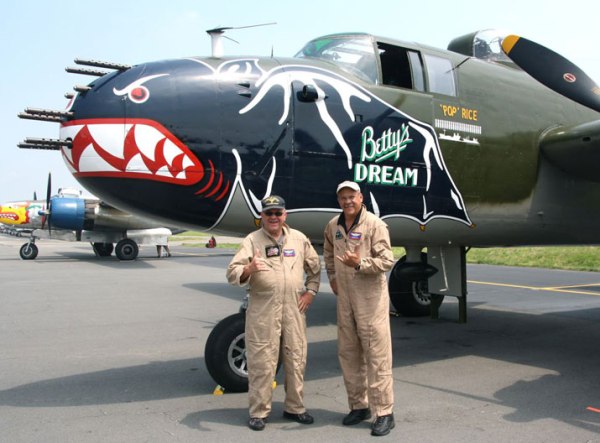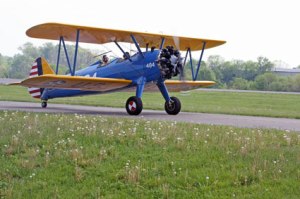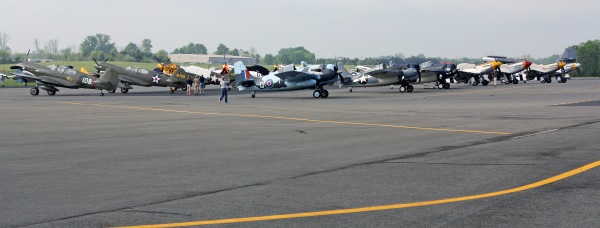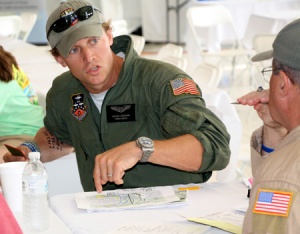
Co-pilot Bill Miller (left) and pilot Alan Miller pose in front of Betty’s Dream in May 2015 after a practice run for the Arsenal of Democracy Flyover. (Photo: K. Daniel Glover)
Originally published on the FAA’s internal website and at Medium
By K. Daniel Glover
If one slogan could capture my thoughts at lunchtime on May 7, this would be it: “I flew in the belly of a B-25 bomber, and all I got was this lousy motion sickness bag.” That’s how I felt as I exited the floor hatch of Betty’s Dream, stepped onto the tarmac at Culpeper Regional Airport in Virginia and inhaled a much-needed breath of fresh air after a rough flight.
But if a pilot in the Commemorative Air Force had asked me later that day whether I’d ever want to fly in a World War II aircraft again, I probably would have said, “When do we take off?” I don’t think I could resist an adventure like that — even though I get anxious about flying in general and even after having endured the worst flight of my life.
I am a writer for the Federal Aviation Administration and talked my way onto Betty’s Dream while reporting an advance story on the Arsenal of Democracy Flyover for the agency’s internal website. With several high-profile media outlets covering the event, I figured my chances of getting a seat were slim but made my pitch anyway for a flight with good video potential.
Two months and many pestering emails later, I finally heard from Leah Block at CAF: “I will put you on one of the trainers, so you should be able to take some great shots. … You will fly from Culpeper. In the air about an hour.”

The writer originally was scheduled to fly in this
Stearman trainer. (Photo: K. Daniel Glover)
And that’s the point at which my nerves began to fray. The journalist who practically begged for a seat in a 70-year-old warbird suddenly remembered he used to drive up to 10 hours one way for assignments in order to avoid flying in modern aircraft.
When I asked to fly along, I thought I’d be in the air a half-hour max. Fifteen minutes would have been plenty. Now I was looking at an hour in a “trainer”? I didn’t even know what that meant until I clicked to the Arsenal of Democracy website again.
Then I started asking frantic questions. “Do you know yet what type of trainer I will be flying in? And just to prepare myself mentally for the experience, what maneuvers can I expect in the air? My co-worker who is a pilot said I probably want to avoid being turned upside down.”
That was an understatement. I definitely did not want to be part of any acrobatic maneuvers, but I couldn’t bring myself to openly admit that.
Leah reassured me that the flight — later confirmed to be on this Stearman biplane so I could get the best GoPro footage — should be relatively calm and that the pilots had been told not to subject us newbies to any “funny business.” But I was on edge for the next 10 days.
By the morning of the flight, I was more excited than nervous — at least for a few hours. I stopped at a 7–11 on the way to Culpeper to check for Dramamine, but the store did not have the non-drowsy formula. I opted for alertness over peace of stomach, a bad choice in hindsight.

World War II aircraft filled the tarmac at Culpeper Regional Airport earlier this month in preparation for the Arsenal of Democracy Flyover. (Photo: K. Daniel Glover)
I was in awe as I drove past the airfield and saw the array of aircraft on the tarmac. My favorites were the P-51 Mustangs and F4U Corsairs, the latter of which I remembered best from the short-lived 1970s television series “Baa Baa Black Sheep.”
I went to work after registering at the press office. I snapped a few photos of the warbirds from a distance, listened to part of the pre-flight safety briefing for all pilots and attended a short press conference.

Andrew McKenna, who owns and flies a P-51 Mustang and a North American T-6 Texan, talks with a colleague during a pre-flight safety briefing. (Photo: K. Daniel Glover)
Soon after the press conference, a guide pointed a few of us toward the Stearman planes. We found our designated rides by using the tail numbers on our press badges.
“I’m now at my assigned plane — and pretty well terrified,” I posted to Facebook at 10:07 a.m. My hands were shaking uncontrollably, and my legs were wobbly. I couldn’t even picture myself maintaining enough composure to climb (or fall) into a plane that small, let alone fly in it for an hour without having a panic attack.
Fortunately I only had to ponder that potentially embarrassing fate for a few minutes. When owner/co-pilot John Weyrich arrived, he said he hadn’t realized the ride-along was part of a practice run for the flyover the next day. That being the case, he didn’t have a spare seat for me — but the event organizers found me another spot on a B-25 Mitchell.
(more…)
 Originally published on the FAA’s internal website and at Medium
Originally published on the FAA’s internal website and at Medium




